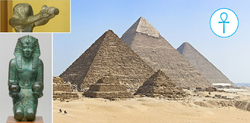- Retour accueil
- Vous êtes ici : Blog The Pyramids of the Cold The Pyramids of the Cold Section 1 • The evaporative cooling passage
The Pyramids of the Cold Section 1 • The evaporative cooling passage
Publié par Bruno Coursol dans The Pyramids of the Cold le 12/04/2022 à 20:17
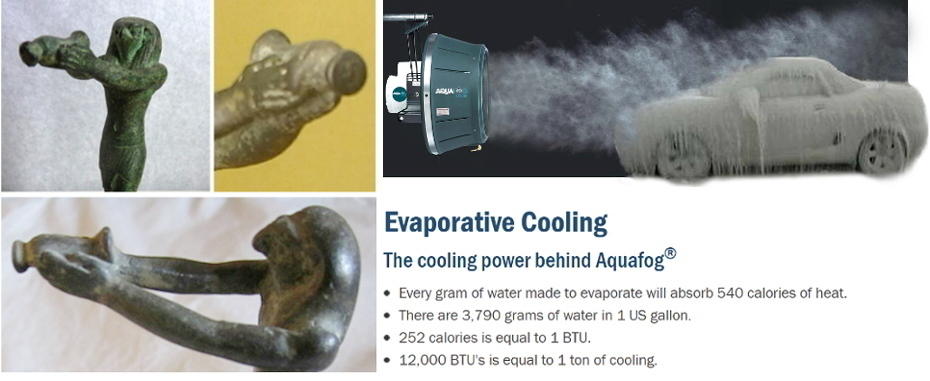
The ancient Egyptian god Horus, holding the fog nozzle of the evaporative cooling passage of the Great Pyramid.
Horus images : E3752 from the Louvre Museum and figurine of Horus DUT162 also from the Louvre Museum ; Paris, France, Hauteur : 9 cm ; Largeur : 2,7 cm ; Profondeur : 6 cm. Date de création/fabrication : Basse Epoque (664 - 332 BCE).
Evaporative cooling applications webpage screenshot : AquaFog® from Jaybird Manufacturing Inc (Pennsylvania, USA).
The Pyramids of the Cold - Section 1 • The Evaporative Cooling : the Horizontal Passage
In summary : the horizontal passage of the Great Pyramid of Giza was designed to transform pressurized liquid water coming from the inclined well, into a fog of liquid microdroplets that would evaporate and create evaporative cold, most probably close to 5°C (41°F). The cold would be stored into the Queen's chamber, where a copper plate cold exchanger would have allow the cooling of a Solvay-like ammonia-soda process chemical manufacturing of sodium carbonate (the purest mineral form of natron), and sodium bicarbonate.
Modern evaporative coolers biggest problem is salt deposit, it is called encrustation, and it is exactly what has been noted in both the horizontal passage and the Queen's chamber of the Great Pyramid : hard and up to one-half inch thick incrustation of salt, everywhere in these parts of the pyramid.
1.01 The surprising efficiency of the evaporative cooling process that created cold in the horizontal passage of the Great Pyramid of Khufu, is still used today in modern evaporative coolers
"Evaporative cooling exploits the fact that water will absorb a relatively large amount of heat in order to evaporate (that is, it has a large enthalpy of vaporization). The temperature of dry air can be dropped significantly through the phase transition of liquid water to water vapor (evaporation). This can cool air using much less energy than refrigeration."
"Evaporative coolers lower the temperature of air using the principle of evaporative cooling, unlike typical air conditioning systems which use vapor-compression refrigeration or absorption refrigeration. Evaporative cooling is the conversion of liquid water into vapor using the thermal energy in the air, resulting in a lower air temperature". https://en.wikipedia.org/wiki/Evaporative_cooler

Vertical elevation of the lower (northern) end of the Grand Gallery of the Great Pyramid of Giza, showing the joint-lines in the Western and Eastern walls, and in particular the continuous expansion joints that are suggesting thermal stress was applied on the structure : that is constraint due to a change in temperature.
1.02 The structural anomalies of the first 64 feet of the horizontal passage
The following excerpt is from "Great Pyramid Passages Vol 1, 1910 edition" by John and Morton Edgar, paragraph ref. 583, page 293 : https://archive.org/details/GreatPyramidPassagesVol11910Edition/page/n301/mode/2up
Paragraph. ref. 583 : "As I indicated in a former letter, the masonry of this Horizontal Passage is very symmetrical. For a length of about 64 feet from the beginning of the roof at the Grand Gallery end, each wall is built in two equal courses. In each of these courses there are 15 stones of one uniform size, namely, 41*4 inches in length, and half the height of the passage in breadth — Plate IX. The vertical joints in the upper course are in line with those in the lower ; and those on the east are in direct opposition to those on the west wall."
1.03 The wider and continuous joints filled with resin or tar
The following excerpt is referring to the initial observations made by Dormion, before discovering the fine sand lining behind the blocks of the horizontal passage. Source : https://www.greatpyramidexplanation.com/easyUp/file/10_07_horizontalcorridor.pdf
"One more detail from Dormion: some blocks of this part of the horizontal corridor have a wider gap in between (2-3mm). The external part has been filled by mortar, while the internal part by something black and rubbery, maybe coal tar or vegetal resin. Also the first part of the floor is atypical: the blocks are narrow and often side by side, showing a poor structural rigidity, almost a propensity to warp (dis. G19). These details may show the purpose of the architect."

The Dendera Light in the Hathor temple, is a representation of the fog of microdroplets of liquid water, transforming itself in vapor and by doing so, creating the evaporative cold designed to cool down the Djed pillar (more probably a Solvay-like tower). The Light Bulb shape of the Dendera Light is constrained by the shape of the horizontal passage.
The snake inside the Dendera Light is a representation of the pressurized water of the inclined well and getting out of the fog nozzle of the pyramid (please read Section 5 on that matter : the waters of the inclined well). More on the Dendera Light in Section 2.
Photograph of the Dendera Light, thanks to Kairoinfo4U and posted on flickr : https://www.flickr.com/photos/manna4u/14525094039/in/photostream/
Lotus seed head thanks to Dinkum : https://commons.wikimedia.org/wiki/File:Nelumbo_nucifera_%28fruit%29.JPG

The fact that the Dendera Light is made of liquid water that transforms itself in a magical way, is exactly what are describing ancient Egyptians themselves : [About the snake inside the Dendera Light Bulb] "The field surrounding Ra’s snake form is referred to in ancient Egyptian literature as protective magical energy in liquid form that all gods and pharaohs possess (Faulkner 1970*)." https://ahotcupofjoe.net/2016/11/dendera-light-bulb-and-bagdad-battery-nonsense/
The evaporative cooling passage of the Great Pyramid of Giza and the Queen's chamber were discovered with a very hard encrustation of salt, up to one-half inch (1.3 centimeter) thick. That salt is the signature of the evaporative cooling process.
Please read Section 17, about Akhenaten and Nefertiti, for the explanations of the Ankh being the symbol of the evaporative cooling.
The elevation loss of 3.8 inches is between the start of the collecting ramp (858.4 inches) and its end (854.6 inches). Elevation data (inches) : "The pyramids and temples of Gizeh", by Petrie, W. M. Flinders (William Matthew Flinders), Sir, 1853-1942 ; section 40 (page 66) : "Passage to Queen's Chamber"
1.04 The horizontal passage was an evaporative cooling conduct
The first clue of the real function of the Great Pyramid of Giza, came from what we call today the horizontal passage. Actually, this passage is really not that horizontal at all. Inside, is a portion that is actually a ramp, a 32 meters long ramp with a 0,3% slope. And that puzzled me, because what the heck right. A ramp here?
And that ramp was not the only weird thing about it. There was, on the first half of the passage, many troubling things :
1/ the blocks were very small, and that is completely uncommon in all the pyramid, because it is the worst thing to do if in a "common structural sense" : you need to get every block resting on top of two different ones to maximize the strength of the structure. In that first part of the passage, every single block is perfectly fitted on top of another one, forming a continuous joint between them.
2/ These joints were not only continuous but also larger, and filled with a strange black filling resembling to resin or tar.
3/ Each side of the passage here, were also perfectly symmetrical to one another.
4/ Behind these blocks, we also discovered there was some sand.
That's a lot of uncommon things, and suddenly, I got it. Because, when you add up the fact that a few feet away you have the grand gallery, and just above of it something that is nothing else than a big water tank, and that is the King's chamber, you have water in mind now.
When I was younger, I used to have an air cooler, the one you just have to put water in it to get fresh air. And that was what this passage was all about. The slope was intended to get water flowing, very slowly, and evaporate itself. Because when the water transforms from liquid to gas, it does cool the air. It is actually called an air adiabatic cooling system. It doesn't cost a thing, and can be very effective when the air at the beginning of the process is very hot, and very dry (and that part is gonna be very important soon).
So know, we understand why we have so many oddities in the first part of the passage. This first half is where most of the cooling was taking place if we make some air coming from the very beginning of the passage. The joints, were expansion joints (large and continuous). The sand was here to absorb any expansion and distortion forces. The blocks were small because less susceptible to crack.
And at the end of the passage, we have a 50 cm step (that's a big step). But in fact that step is nothing else than a basin, for the water.
This water was here to accumulate and store the cold that was produced in this passage. Probably this basin was in fact covered with a wood casing, so it was perfectly waterproof.
This horizontal passage was designed to do 2 things : cool down the water temperature in the basin and let the air coming from the grand gallery, passing through the passage.
Because under the niche of the Queen's chamber was an air vent going to the subterranean complex allowing fresh air and cold water to flow to the complex.
Everything in the first part of the horizontal passage of the Great Pyramid is designed to reduce the stresses on the superstructure induced by multiple temperature variation cycles. It is difficult to say how long was the cycle, but let's say it was about 15 to 20 minutes. It means that during all this time, the first part of the passage had plenty of time to warm up back to the temperature of the grand gallery. And every 15 to 20 minutes, it was cooled down again. The problem is not the cooling down, but the endless cycle of cooling down and warming up again. That is what stresses the structure.

The Queen's chamber of the Great Pyramid of Giza. Right image courtesy of University of California at Riverside, California Museum of Photography, Keystone-Mast Collection : http://www.oac.cdlib.org/ark:/13030/kt1h4nd3jb/?order=2&brand=oac4
1.05 The up to one-half inch thick salt incrustation in the Queen's chamber & Horizontal passage
The salt encrustation inside the Great Pyramid has been mainly documented in the Queen's chamber, where it could have been up to one-half-inch thick in some places, 1.3 centimeter, and in the horizontal passage, but also in a smaller extent in the lower part of the Grand Gallery and in the ascending passage.
There is no salt encrustation documented anywhere else, and its distribution is perfectly explained by the evaporative process and the particular layout of the junction between the Grand Gallery, the ascending and horizontal passages.
The following excerpt is from "Great Pyramid Passages Vol 1, 1910 edition" by John and Morton Edgar, paragraph ref. 584, page 293 : https://archive.org/details/GreatPyramidPassagesVol11910Edition/page/n301/mode/2up
Paragraph. ref. 584 : "Following these uniform sets of 15 stones, are two long stones in each course, averaging about six feet in length, after which each wall is built in one course only, apparently as far at least as the drop in the floor of the passage ; but beyond this, on to the Queen's Chamber, the very thick and hard incrustation of salt which entirely covers the walls of this passage, made it impossible for us to locate the joints with any certainty. This salt incrustation is peculiar to the Horizontal Passage and Queen's Chamber, although a little of it may also be seen on the walls of the First* Ascending Passage."
* For some authors, the first ascending passage starts at the granite plugs and ends with the start of the Grand Gallery, the second ascending passage.
Excerpt from "The pyramids and temples of Gizeh" by Petrie, W. M. Flinders (William Matthew Flinders), Sir, 1853-1942 : "The size of the chamber (after allowing suitably in each part for the incrustation of salt) is on an average 205 85 wide, and 226*47 long, 184*47 high on N. and S. walls, and 245*1 high to the top of the roof ridge on E. and W. walls." https://archive.org/details/cu31924012038927/page/n103/mode/2up
1.06 Salt encrustation is the signature of the evaporative cooling process... even nowadays
Of course, the salt encrustation in evaporative cooling systems is not about table salt NaCl, but primarily calcium carbonate CaCO3 also called calcium scale, or limescale.
With most of the pyramid built with limestone, this is not a surprise that limescale would have been a major problem.
From "Evaporative Cooler : Self Salt Clean", by Mohammed Ali Bahobail from the Department of Architecture and Building Sciences, College of Architecture and Planning, King Saud University, a Public university in Riyadh, Saudi Arabia : "Evaporative coolers are relatively economical, less expensive to install and to operate. They are consuming less electricity than a refrigerated unit, and they do not need an expert to maintain. In addition, evaporative coolers provide the building with a fresh humid air. However, evaporative coolers have some disadvantages; one of them is the deposited salt. Water usually has a high percentage of mineral. The evaporative mechanism will leave mineral deposits on the pads and interior of the cooler. This cumulative mineral will close the porous of the wetted pads and damage them and will participate to corrosion of the cooler frame."
The work made by Mohammed Ali Bahobail is about coolers designed with wetted pads where water is circulating, there is no fog of microdroplets, but the principle is the same and the deposited salt problem is the same.
https://cap.ksu.edu.sa/sites/cap.ksu.edu.sa/files/imce_images/jap_ksu_jan2013_e1_0.pdf
1.07 The 1998 salt encrustations cleaning
Unfortunately, the salt deposits have been removed since the first explorers of the pyramid reported its presence, most likely when the chamber was cleaned by Zahi Hawass in 1998 :
Zahi Hawass (Director General of the Giza Pyramids, between 1987 and 2002) : "Each visitor produces nearly an ounce of moisture with a high saline content through their breath and perspiration. This results in the accumulation of salt, which leeches into the limestone and plaster and gradually causes them to crumble into powder. So, in 1998, we spent 12 months cleaning the salt."
Excerpt from https://www.world-archaeology.com/features/pyramids-excavation-and-preservation/
Mr Hawass is obviously blaming tourists for the salt encrustations in the Queen's chamber, but when the first explorers of the pyramid discovered these encrustations, there wasn't any tourist at all visiting the pyramid. The remark of Mr Hawass, is pretty funny though : did we ever had to periodically close down limestone built churches, cathedrals or any other pyramid or building made of this material (I guess in Mr Hawass' mind, limestone is a key element of the salt deposits in the Great Pyramid), just to remove the salt? Be that as it may, salt deposits were only documented in the Grand Gallery in its lower part (most probably just around the junction with the horizontal and ascending passages); did tourists stop breathing passed this point, and did they climb the gallery and visit the King's chamber in total apnea ? Were they offered respiratory masks ?
The cleaning of the salt deposits is actually a real drama, because before 1998 it was still possible to know exactly at what temperature the Queen's chamber was cooled down, simply by analyzing the crystalline structure of the deposits, the size and shape of the crystals.

The sarcophagus of the Great Pyramid of Giza, was a biosand filter originally operated in the little room located between the antechamber and the entry to the Grand Gallery. The water treatment by biosand filtration was to control scale, corrosion, and microbiological growth within the evaporative cooling process.
"Ram Pokherai drinks clean water from his family's biosand filter. Clean water helps children stay healthy, which means they are less likely to need time away from school, so their education improves. Providing clean water has important knock-on effects." Courtesy of Editorial, Humanitarian & Travel Photographer Gavin Gough : https://www.gavingough.com/clean-water-in-rural-nepal
1.08 The sarcophagus was a biosand filter for water softening
I first thought that the sarcophagus found in the King's chamber was a biosand filter for production of drinking water for the crewmembers of the Hauling Beetle, but I have to admit it was a little… romantic, I would say.
Nowadays, evaporative cooling is an extraordinary process, but like every process it has some disadvantages, and the most problematic is surely limescale : salt encrustation.
4500 years ago, ancient Egyptians had to deal with that same problem, and they did exactly what we do today : they softened the water coming from the King's chamber, and they used sand filtration.
The most amazing thing is that everybody knows the sand filter that was used inside the Great Pyramid to soften the water : it is the sarcophagus (more on the sarcophagus in Section 18).
1.09 What is a Biosand Filter?
A biosand filter (BSF) is an adaptation of the traditional slow sand filter, which has been used for community drinking water treatment for 200 years. The biosand filter is smaller (about 1 m tall, 0.3 m wide on each side) and adapted so that it does not flow continuously, making it suitable for use in people’s homes. The filter container can be made of concrete or plastic. It is filled with layers of specially selected and prepared sand and gravel. The sand removes pathogens and suspended solids from contaminated drinking water. A biological community of bacteria and other micro-organisms grows in the top 2 cm of sand. This is called the biolayer. The micro-organisms in the biolayer eat many of the pathogens in the water, improving the water treatment.
Pathogens: micro-organisms in water that make us sick
Suspended Solids: dirt and other small pieces in the water (may also be called “turbidity”)
Source : https://www.cawst.org/services/expertise/biosand-filter/more-information

"Modeling Improved Performance of Reduced-Height Biosand Water Filter Designs" by James A. Phillips and Samuel J. Smidt, and published on MDPI : https://www.mdpi.com/2073-4441/12/5/1337
1.10 Sand filter is the softening primary step N°1 for evaporative cooling systems
"How to fix hard water is a major question of water treatment or water purification process. Water hardness test is a process of removing undesirable chemicals, materials and biological contaminants such as suspended particles, dissolved particles, iron content, bacteria etc. from contaminated water."...
And : "Sand filter is the primary step of WTP Water Treatment Process for collecting pure water system from water hardness. Sand filter remove water substance from water. Sand filter remove iron from hard water and it is used for water purification. This is very old technique so at present it is not developing broadly."
Source : https://autogarment.com/wtp-remove-water-hardness-from-hard-water/
Also : "Effective water treatment works to control scale, corrosion, and microbiological growth within an evaporative cooling system. It also helps to ensure heat transfer efficiency and extend the service life of the equipment."
"When an evaporative cooling system rejects heat to the atmosphere, only pure water is evaporated. As this occurs, the dissolved ions—naturally occurring in the makeup water source—are left behind. Without proper water treatment, the dissolved ion concentration increases as evaporation continues and, at some point, will reach saturation of the ions, which can lead to scale. The most common form of scale is calcium carbonate. Preventing scale via water treatment impacts the efficiency of heat transfer, thereby reducing energy consumption of the entire system."
"Microbiological growth in evaporative systems can lead to accelerated corrosion rates, heat transfer deficiencies due to biofilm, as well as human health related concerns. There are a variety of reasons why one system may experience higher biological activity than another. Tower location, nearby construction or farming operations, the makeup water source, and more can all lead to an increased level of bacteria in the water."
Excerpt from the website of EVAPCO, Westminster, Maryland, United States : https://www.evapco.com/faq/answer/water-treatment-evaporative-cooling-system

The sarcophagus of the Great Pyramid of Giza was set in what is today a storage and electrical room that has a direct access to the King's chamber. For more on the sarcophagus, please read Section 18.

The junction of the Grand Gallery of the Great Pyramid of Giza with the inclined well and the horizontal evaporative cooling passage.
On the above image of the Great Pyramid Grand Gallery lower end, the opposite 5 pairs of holes in which the junction wooden ramp would have been set onto massive wooden beams are clearly visible, as well as the markings made by the ramp itself (Rm). On this picture though, the junction imprint (Ji) in the middle of the cut-off isn't visible.
1.11 The junction Grand Gallery / inclined well / horizontal cooling passage of the Great Pyramid
On the first above image, what is amazing to notice is that the modern layout that have been designed for the tourists to walk on the lateral ramps, is actually exactly reproducing the original design made by the ancient Egyptian themselves so they could operate the 2 hauling beetles.
It is true for the "modern walking trail" on the floor, and it is also most probably true for the safety rails. If you look closely at these rails, they perfectly fit with the height of the ascending passage ceiling.
On this particular image, it is then pretty easy to imagine the (most probable) fixed caisson in which the impactor was moving : just imagine that the safety rails are completely wooden boards covered both on the sides and on top of them, and you have the fixed wooden caisson.

The junction of the ascending passage of the Great Pyramid of Giza, with the horizontal passageway, showing the little imprint on the cut off and the holes in the walls. The holes allowed a wooden ramp set on massive wooden beams, to connect the central gutter of the Grand Gallery to the ascending passage.
The only image of the Junction imprint that I was lucky to find, is from John and Morton Edgar in "Great Pyramid Passages Vol 1, 1910 edition", plate CXLIX, page 274 : https://archive.org/details/GreatPyramidPassagesVol11910Edition/page/n283/mode/2up
1.12 The junction wooden ramp : structural continuity but with water (and probably also air) exchanges towards the cooling passage
The junction wooden ramp would have ensure the structural continuity between the Grand Gallery and the inclined well, while the junction imprint would have allow the pressurized water to get out of the well.
The wooden ramp would have been supported by massive beams set in the 5 pairs of very impressive opposite holes in the walls of the junction area.
If the fixed caisson really existed, when the impactor would have moved inside, air would have been pushed in front of it and would have been redirected to the cooling passage to renew the air and get rid of the humidity without being forced into the well itself. Humidity is the evaporated water that resulted from the evaporative cooling process.
The ramp couldn't be in solid rock because they had to bring in all the equipment of the Queen's chamber and the fog nozzle, and because they needed to get it out after the shutdown procedure; but also because they most probably had to regularly get in the horizontal passage to check, clean and repair these same equipments.
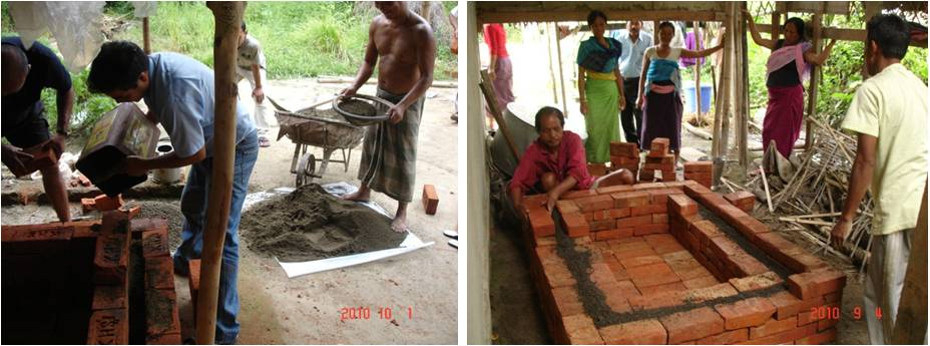
The use of wet sand as thermal insulation, in the construction of cool chambers. Left : Construction of Zero Energy Cool Chamber at Thoubal district, Manipur (India). Right : same thing but at Karong Village.
1.13 The Zero Energy cool chamber sand of the horizontal passage of the Great Pyramid of Khufu
The idea that the horizontal passage of the Great Pyramid was designed as a part of a cooling unit, is reinforced by the fact that fine sand was found behind some blocks of the passage.
If my theory is right, then that same sand would have been probably set all around the entire structure [horizontal passage + Queen's chamber] ; exactly like it is shown on the above photographs of the construction of Zero Energy Cool Chambers, in India.
After all, when the French team who discovered the sand behind the blocks, reported it, they were asked to stop their work. We don't know the entire extend of the sand casing behind the blocks.
I first thought the sand was here to reduce the thermal stress on the structure, due to the constant sudden changes in temperature that occurred in the first part of the passage, and maybe it also served this problem ; but it was most likely to be essentially a thermal insulation.
1.14 The Dormion and Goidin discovery on the fine sand lining of the horizontal passage of the Great Pyramid
Excerpt from the Los Angeles Times article "Scientists Seeking Hidden Vaults in Great Pyramid Find Only Sand", written by Michael Ross, September 1986 : https://www.latimes.com/archives/la-xpm-1986-09-09-mn-12810-story.html

"A team of French scientists searching for hidden, treasure-filled rooms in the Great Pyramid of Cheops suspended work Monday after drilling three holes through an interior wall and finding only sand. But the French team and the head of the Egyptian organization supervising the work said they believe that the presence of a powder-fine lining of sand between the interior stones of the Great Pyramid supports their theory that secret chambers lie deep within the 4,600-year-old tomb of the Pharaoh Cheops.
“The sand means the ancient Egyptians are protecting something, something very serious and meaningful,” said Ahmed Kadry, head of the Egyptian Antiquities Organization. He said that although the French team failed to find and penetrate the cavities, samples taken from the wall beyond the sand lining indicate that it is made of a fine, soft limestone used by the ancient Egyptians for ornamental carvings on royal tombs.
“We can be sure now that there are cavities, and not just structural or stress cavities but something much more mysterious,” he said.
The French mission, headed by Gilles Dormion and Jean-Patrice Goidin, two architects who postulated the existence of secret rooms in the Great Pyramid on the basis of architectural anomalies in the interior stonework, had hoped to bore four holes through the wall of a gallery leading to the so-called Queen’s chamber. The plan then was to observe and photograph the interior with an endoscope, an optical instrument developed for viewing the interior of human organs.
However, the work was suspended after five days when, after boring three holes through more than eight feet of hard limestone, the drills hit the fine sand lining. Jacques Montlucon, an engineer with the French National Electric Company, which is providing technical expertise for the project, said the work was suspended because the drills being used are not suitable to bore through sand.
The existence of hidden chambers in the Great Pyramid has long been suspected, but there was never any real evidence until last May, when the French found what they said appeared to be three spaces, measuring 6 feet by 9 feet, off of the Queen’s gallery. The discovery, which the French said could indicate the presence of hidden storerooms, created a flurry of excitement among Egyptologists, who for the most part have assumed that all the treasures of Cheops were plundered long ago.
Not all the experts share Kadry’s conviction that there are secret chambers, but discovery of a sand lining about 10 to 17 inches thick between the great stones is regarded as a puzzling and exciting find in itself."

The Carrier diagram, or "Carrier psychometric chart", is used for determining the temperature and humidity properties of a constant pressure air-water mixture. Thanks to Arthur Ogawa : https://commons.wikimedia.org/wiki/File:Psychrometric_chart.png and posted on https://en.wikipedia.org/wiki/Psychrometrics
1.15 The Carrier psychometric chart
The dryer the air is at the beginning of the cooling process, the greater amount of water it would be able to take, and the colder it is gonna get. For example, if you have an air at 0% humidity and you know you can get to 100% humidity, then the temperature can be cooled down from 20°C to 6.5°C (68°F to 43.7°F).
Of course, this is only true for an adiabatic cooling, at atmospheric pressure. The fact is that the evaporative cooling is pressure dependant : if the fall of the impactor was also used to push air into the horizontal passage, then the pressure would have increased and the evaporative cooling would have get more efficient.
In my opinion, in regards of all the structural particularities of the horizontal passage and the massive anti-thermal shock layout, this is what they did, and I suspect they were able to cool down the Queen's chamber at about 5°C (41°F), whatever the ambient air temperature was.
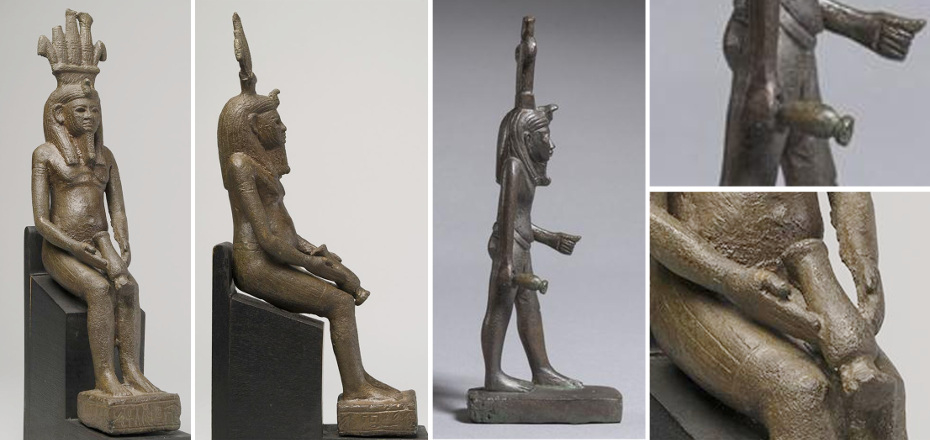
Hapi, the ancient Egyptian god of the Nile and flood. Left : Statue of the God Hapy. Late Period, Dynasty 26, VII–VI cent. B. C. © The Pushkin State Museum of Fine Arts. Right : Statuette du dieu de la crue du Nil Hâpi, N5030 from the Louvre Museum (via l’Agence photo de la Réunion des Musées nationaux et du Grand Palais © Musée du Louvre, Dist. RMN-Grand Palais / Christian Décamps).
1.16 Hapi, the god of the representation of the water supply of the pyramid, holding the evaporative cooling fog nozzle
Horus is not the only god holding the fog nozzle, here are other examples with the god Hapi. The way that Hapi is holding the fog nozzle should convince the greatest skeptics that this so particular element wasn't a libation vessel used for purification or baptism.
It is not a coincidence that Hapi is also holding the fog nozzle : Hapi was the god of the Nile, and we've already seen that the water used inside the Great Pyramid for the impactor to move and the cold to be produced, was most probably coming from the Nile.
Apep was the representation of the inclined well waters, pressurized by the fall of the impactor, and "Apep was seen as a giant snake or serpent leading to such titles as Serpent from the Nile" (Source : Wikipedia).
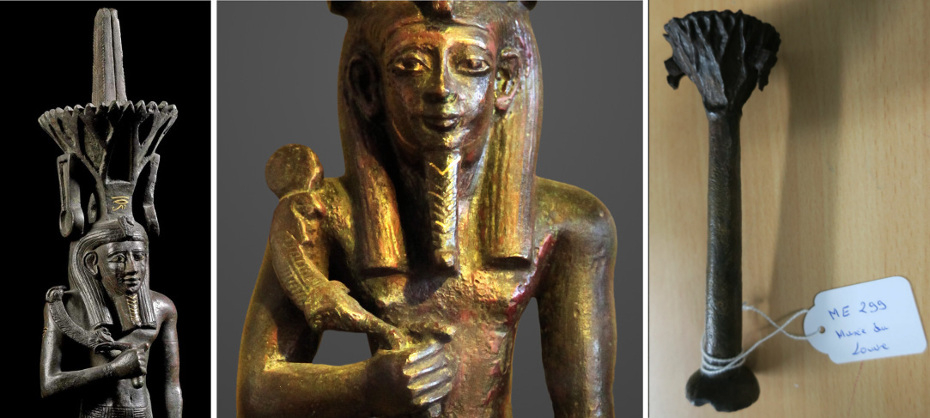
Nefertem amulets showing the Khepesh (right hand and shoulder). From left to right © British Museum EA64480, Le Louvre E 10665 and Le Louvre ME 299 (Nefertum emblem)
Nefertem is the glorifying representation of the hardware that was installed inside the horizontal cooling passage : the fog nozzle + the supply pipe + the fittings and their spanner wrenches
1.17 Nefertem 1 • The "close or not close" reference
The brass fire fog nozzle shown in the above photograph is designed to be manually handled and is equipped with a handle that doesn't appear on the representations of the fog nozzle of the Great Pyramid. That nozzle was either functioning or not, depending if the inclined well was pressurized or not.
And that echoes to the Nefertem description :
From Wikipedia : "Nefertem, possibly "beautiful one who closes" or "one who does not close", (also spelled Nefertum or Nefer-temu) was, in Egyptian mythology, originally a lotus flower at the creation of the world, who had arisen from the primal waters". https://en.wikipedia.org/wiki/Nefertem
"Close or not close" is not a bad definition for what was really representing Nefertem : the fog nozzle of the horizontal passage. This nozzle was eventually nothing else than a huge water tap that transformed pressurized water from the inclined well (the ascending passage) into a mist of microdroplets of liquid water. There was no valve though, just the fall of the impactor inside the grand gallery of the Great Pyramid that pressurized the well.
1.18 Nefertem 2 • The "who had arisen from the primal waters" reference
That part have already been discussed in the previous post on the myth about Apep : the primal waters are describing the inclined well waters themselves.
God Nefertem is another metaphor, this time it is representing the fog nozzle itself and its operating.
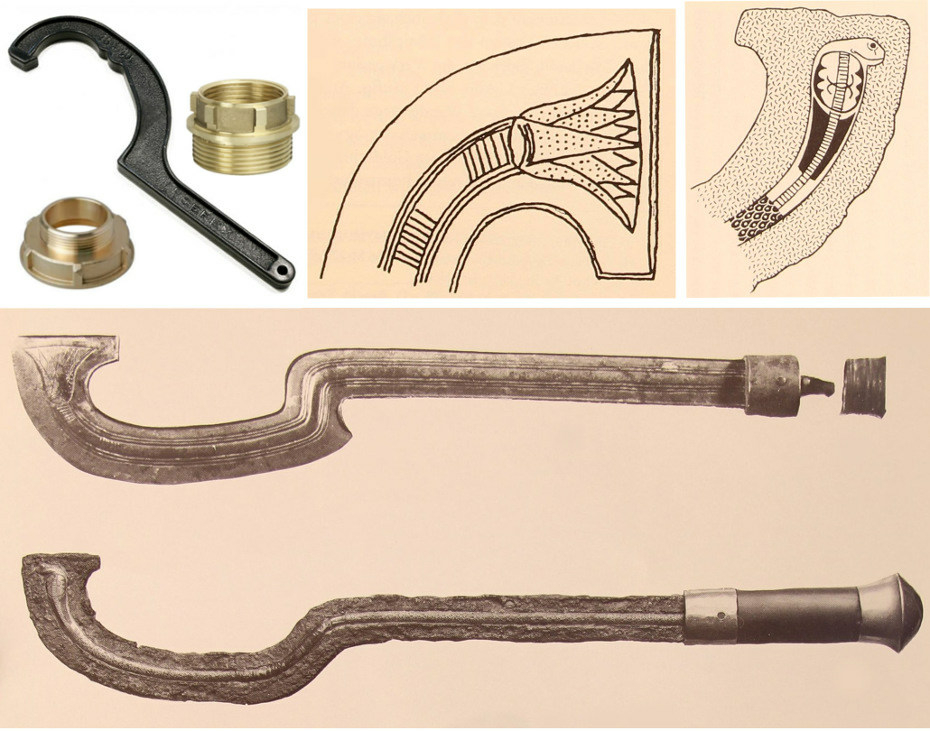
The Khepesh Scimitars of the Nefertem amulets were spanner wrenches for pipe connecting fittings.
Top left photograph above : a modern spanner wrench designed to connect or disconnect metal fittings. The tooth at the end of the curved part of the tool is designed to engage onto the protuberances of the fitting. Other pictures are ancient Egyptians Khepesh Scimitars (exact dating is unknown to me).
1.19 The Khepesh Scimitars of the Nefertem amulets were spanner wrenches for pipe connecting fittings
According to scholars, ancient Egyptian God Nefertem (also Nefertum, or Nefertemu) was the god of the lotus blossom who emerged from the primeval waters at the beginning of time. That would explains the huge lotus blossom that Nefertem amulets displayed on their heads.
But most of the time, Nefertem is also having a Khepesh-Scimitar on the right hand, that is described as a warfare blade with sharpened edges, even if many examples have dull edges that apparently were never intended to be sharp.
According to scholars, again, "it may therefore be possible that some Khepeshes found in high-status graves were ceremonial variants". But in my opinion, the idea that the reason why some Khepeshes weren't sharp at all, would be because they would have been for ceremonial use, couldn't be more wrong. Even today, the ceremonial Japanese katanas are maybe the most sharp of all katanas precisely because they are for ceremonial use. They are the best and the most expansive ones. The only katanas or any other kind of sword, that would be with dull edges, are the ones for kids to play, and they would be in plastic or wood.
1.20 Ancient Egyptians were using spanner wrenches
My interpretation of the Khepesh hold by Nefertem is radically different. What I am saying is that pressurized water was directed towards the fog nozzle of the horizontal cooling passage of the Great Pyramid, and for that to be possible, pressure resistant pipes were needed, and that is exactly what is depicted in the Nefertem emblem.
But there is more, because to connect the pipe to the fog nozzle, or pipe pieces to each other, they would certainly have to use connecting fittings. And as a former winemaker, I know one thing for sure about pipes and fittings : when you want to connect or disconnect these elements, you cannot do anything without a spanner wrench (maybe not in the US or in Canada where screw fittings are very rare, but in France, at least).
The Khepesh that Nefertem is holding isn't for warfare, it is a spanner wrench.
On certain representations of Nefertem, like E 10665 from the Louvre Museum (photograph above), we can also see on top of the Khepesh, a circular form in direct contact with the tool (though apparently not to scale). Could that round form be the copper fittings ?
1.21 The higher position of the tooth could indicate that the hook system was different from modern screw fittings
We can see on the ancient Egyptian Khepeshes that the tooth is placed higher in relation to the handle axis than on the modern spanner wrenches and it could mean that the hook system was different : on the modern tool, the tooth is designed to hook to an external piece of the screw fitting, but it is possible that on the ancient Khepeshes, there were sockets carved inside the fittings instead or that it wasn't at all screw fittings.

What is remarkable with these Khepeshes, is that they can probably indicate what was the pipe diameter they were designed for, and we can find out if different diameters were used or not. We also know they were probably using screw-type fittings.
1.22 Nefertem is the personification of the horizontal passage fog nozzle of the Great Pyramid
To be convinced of this, please note that on these pictures above of 2 different Khepeshes, one is engraved with the lotus flower, while a snake appears on the other one, showing the 6 teeth / needles.
Both elements, the circular shape of the snake and the lotus flower, are representing the same thing : the fog nozzle.

Left (loose clamp) : EG-ZM2426 (3.2 x 3.8 x 1.3 cm) and : EG-ZM2425 (locked clamp) (3.5 x 3.6 x 1.6 cm) from the Rijksmuseum van Oudheden in Leiden. Material : faience. Right : Ring, Accession Number: 2008.190.289 (1070 - 712 BCE) from the Metropolitan Museum of Art, New-York
1.23 The representations of quick-release clamping rings
On the above figures of Horus, the fog nozzle is completely disconnected from the Nefertem copper pipe, and Horus hold it in both hands. To disconnect and reconnect the nozzle to the rest of the equipment, you need 2 things : high pressure resistant clamping rings and a spanner wrench.
I've already found the spanner wrench, it is very often associated with figures of Nefertem and, thanks to Elizabeth Fleming from the Griffith Institute and her colleague Cisco, I've just found representations of the clamps in the National Museum of Antiquities Rijksmuseum van Oudheden, Leiden, Netherlands.
These clamp rings were quick-release clamps
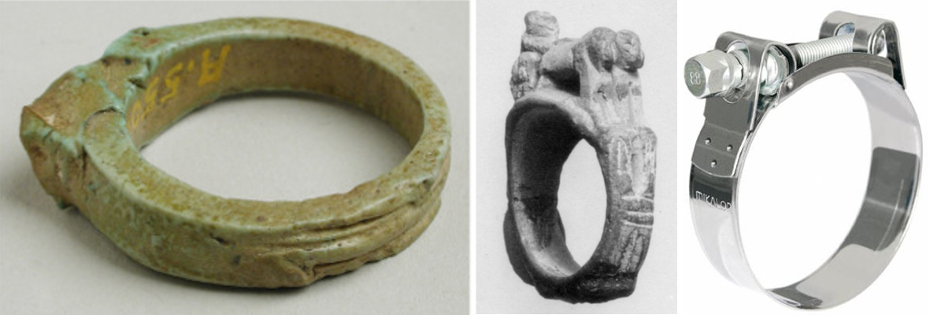
Left : Shen Ring from the LACMA, Los Angeles County Museum of Art. Egypt, New Kingdom - Ptolemaic Period (1569 - 31 BCE). Diameter: 1 1/4 in. (3.175 cm). Center : Ring figure in faience from the Metropolitan Museum of Art, New-York : Accession Number : 17.194.2307, Diam. 3 cm (1 3/16 in.); Bezel: L. 4.5 cm (1 3/4 in.) Right : modern Mikalor Super Heavy Duty Hose Clamp
1.24 The representations of permanent clamping rings
Additionally to these quick-release clamping rings, we can also find representations of more permanent connections, like the 2 representations on the above photographs. These clamps could have been used to connect different pipe sections together probably not in the cooling passage itself, but everywhere in the pyramids, mastabas, etc.

Diagram of the Great Pyramid of Egypt in operation, before the shutdown procedure and the draining of the inclined well.
1.25 Summary of the study : hidden behind the academic vision of the ancient Egyptian religion, a vast number of metaphors are describing some of the most advanced science and technological knowledge of that time : ancient Egyptian gods were nothing else than pharaohs' metaphoric self-glorifications of their theoretical and experimental scientific accomplishments in physics and chemistry.
Pharaohs used the power of Science to legitimate themselves as kings of Egypt : they forged an entire religion, based on science to rule their kingdom, and they presented that science as Magic.
The end game of this technological program that probably started on the very first Dynasty, was the Great Pyramid of Giza where evaporative cooling was engineered in the known part of the pyramid from the pressurized water produced in the inclined well, known today as the ascending passage.
The evaporative cold simply took advantage of the power of water, and was most probably necessary to cool down chemical manufacturing of sodium carbonate and sodium bicarbonate produced by an ammonia-soda Solvay process, as suggested by the very strong ammonia smell and the limestone kiln in the so-called burial chamber of the Red Pyramid. At that time, sodium carbonate was called natron, and it was the salt used for the mummification of the pharaohs (Sections 14, 15 and 16).
The cooling seems to have represented the most difficult part of the process, as suggested by the Step Pyramid's official name : according to scholars, the very first pyramid complex, the Step Pyramid of Djoser, was called "the refreshment of the Gods". No doubt that a more accurate translation would certainly be "the cooling of the Gods".
It means that ancient Egyptians were the first civilization to master a Solvay-like process for sodium carbonate manufacturing, long before it got reinvented in the 1800's in Europe. The key elements of that process is the temperature control of the chemical reactions (the cooling), and the dome shaped plate necessary for the counterflow chemical reactions to occur in an efficient way. That counterflow reaction plate is what really is the disc of Sabu.
As shown with Akhenaten and Nefertiti, the creation of the evaporative cold was the most sacred accomplishment of all (Section 17), and this is exactly what the Dendera Light is all about : the Dendera Light is the fog of microdroplets of liquid water that evaporates and creates the cold. Talking about the snake inside the Dendera Light Bulb : "The field surrounding Ra’s snake form is referred to in ancient Egyptian literature as protective magical energy in liquid form that all gods and pharaohs possess" (Faulkner, Section 2).
Everything that had been done in the Great Pyramid of Giza inspired most of the ancient Egyptian religion, and it had been glorified into what we know today as the Underworld.
The Underworld is referring to the chambers and passages of the Great Pyramid of Khufu, and in particular to the Grand Gallery where a hauling gantry beetle operated a wooden coffin shaped impactor that had a small nested granite block inside it. The impactor generated endlessly, over and over, maybe every 15 minutes the pressurized water that was then transformed into a fog of microdroplets inside the horizontal cooling passage.
The Grand Gallery of the Great Pyramid where the act of hauling was done, is the "Secret Hauling Cavern of the Underworld" described in the Amduat "Book of the Hidden Chamber".
The most important chamber of the Great Pyramid wasn't the King's chamber that only was the main water tank of the pyramid, but the Queen's chamber, the only one on the central axis of the pyramid. Because the Queen's chamber was inaccessible from the rest of the pyramid, it was glorified into the "Hidden Chamber of the Underworld" (Section 11), and because the Queen's chamber was the coolest place in the pyramid (about 5°C / 41°F), and with a constant 100% Humidity rate, this chamber was the one where the biggest amount of very hard salt encrustation had been documented by the first explorers of the pyramid in the 1800's and before it had been removed in 1998 by Zahi Hawass (Section 1). Very hard salt encrustation is the signature of the evaporative cooling process, even nowadays.
The most incredible thing is that pretty much everything I've just said, actually appears in one single myth, but it doesn't originate from ancient Egypt : it is the "Churning of the Ocean" Hindu myth that produces the immortal nectar Amrita. The fact is that the endless churning of water that ends up with the production of an elixir that gives eternal life, is exactly what were doing ancient Egyptians in the inclined well : natron was the salt used for the mummification of pharaohs.
Natron gave eternal life to pharaohs, just like the Amrita (Section 19).
Poster un commentaire

